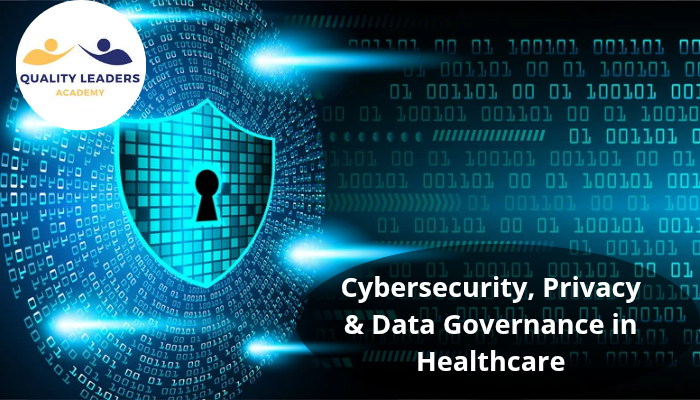Healthcare is more digital than ever. Electronic health records, telehealth visits, wearable devices, and the Internet of Medical Things (IoMT) create powerful opportunities for better care and a much larger “attack surface” for cybercriminals. That’s why data governance sits at the center of any modern healthcare security and privacy program: it defines how data is collected, who can use it, and how it must be protected so patients stay safe and trust is preserved.
Why the risk is real (and growing)

High-value patient records, protected health information (PHI), payment details, and personally identifiable information (PII) attract sophisticated attackers.
Large incidents show the consequences:
The Change Healthcare ransomware incident disrupted billing and clinical flows and exposed millions of records, demonstrating how a single third-party compromise can ripple across hospitals and clinics. That real-world example underlines why organizations must treat cybersecurity, privacy, and governance as interconnected priorities.
Cybersecurity in healthcare: common threats and modern defenses
Common threats include ransomware (systems encrypted and operations stopped), phishing (credential theft through deceptive emails), medical-device vulnerabilities (legacy devices without modern protections), supply-chain attacks (vendors as weak links), and insider incidents (accidental or malicious misuse of privileges).
Modern defenses are evolving fast:
- Zero-trust architectures assume no user or device is trusted by default and require continuous verification.
- AI-driven detection machine learning helps spot anomalies and speed incident detection and response.
- Strong encryption & access controls protect data both at rest and in transit; employ MFA and role-based/attribute-based access.
- Prepared incident response, tested playbooks, reduced downtime, and patient harm.
Guidance from national cybersecurity agencies and sector resources emphasizes layered defenses, continuous monitoring, and vendor risk management as core pillars of a resilient security posture.
Privacy: the patient’s right to control their data
Privacy is about respecting patients’ expectations and legal rights: how their health data is collected, used, and shared. In the U.S., HIPAA establishes baseline privacy and security requirements for covered entities and business associates; in the EU, the GDPR treats health data as a special category requiring strict safeguards and often explicit consent. Many regions now add local laws that expand protections further, so organizations must design privacy into every project.
Practical privacy steps:
- Obtain and manage informed consent with transparency and patient controls.
- Minimize data collection and apply anonymization or de-identification for research/analytics.
- Perform privacy impact assessments before launching new services or data uses.
Data governance: the organizing system that makes security and privacy work

Data governance is the strategic framework that sets policy, roles, standards, and processes for data quality, access, and lifecycle management. Without governance, security rules are inconsistent, privacy controls are ad hoc, and compliance becomes guesswork.
Key components of an effective governance program:
- Data stewardship & ownership, clear custodianship for datasets so someone is accountable for accuracy and access.
- Data quality management, rules, and processes that keep records accurate, complete, and clinically usable. Poor data = poor decisions.
- Cataloging & lineage, a searchable inventory showing where data originated and how it flows through systems (critical for audits and incident investigations).
- Policies & standards, documented rules for access, retention, sharing, and disposal, aligned to law and to clinical needs.
The academic literature supports a privacy-and-security-driven governance model, one that integrates ethical principles, technical controls, and organizational accountability rather than treating those as separate concerns.
Best practices that bring governance, security & privacy together
- Form a cross-functional governance body that includes IT, clinical leaders, legal/compliance, risk, and patient advocates. Shared decisions build trust and usability.
- Adopting least-privilege access and modern identity controls, RBAC/ABAC plus strong identity management, reduces unnecessary exposure.
- Make security and privacy “built-in” (privacy/security by design) require new tools and workflows to meet governance checks before deployment.
- Protect endpoints and IoMT (Internet of Medical Things) devices, enforce device patching, network segmentation, and endpoint monitoring to limit device-based risk.
- Continuous monitoring and tabletop exercises detect anomalies early and rehearse responses so teams act quickly during incidents.
- Vendor & supply-chain oversight requires security controls, contractual SLAs, and incident notification requirements from partners. The Change Healthcare case showed vendor risk can cascade widely.
Challenges and practical trade-offs
Healthcare organizations face real constraints, such as legacy systems, tight budgets, fragmented data silos, and clinician time pressures.
Governance must be pragmatic, prioritize high-risk data and workflows first, show clinical value early, and scale governance capabilities over time. Treat governance as an ongoing program (continuous improvement), not a one-time project.
The human side: trust, ethics, and real patients
Technical controls matter, but so do people. Patients delay care if they fear privacy violations; clinicians need reliable data to make life-critical decisions. Governance that centers patient rights and clinician usability creates safer care and stronger public trust. The United Nations and global health scholars urge governance frameworks that incorporate equity and human-rights perspectives for truly responsible digital health.
Start with governance, protect with security, honor with privacy
Data governance is the organizing backbone that makes cybersecurity and privacy effective. When data governance sets clear rules and responsibilities, security technologies can enforce them, and privacy protections become meaningful in practice. The result is a healthcare system that uses data to improve outcomes without sacrificing patient safety, rights, or trust.
Read also:
Digital transformation and interoperability in healthcare
Social Determinants of Health Framework
Resources:
https://link.springer.com/chapter/10.1007/978-3-031-72524-1_19
https://www.loginradius.com/blog/identity/data-governance-healthcare-practices
https://www.hipaajournal.com/change-healthcare-responding-to-cyberattack
https://unu.edu/iigh/article/digital-security-and-governance-healthcare


